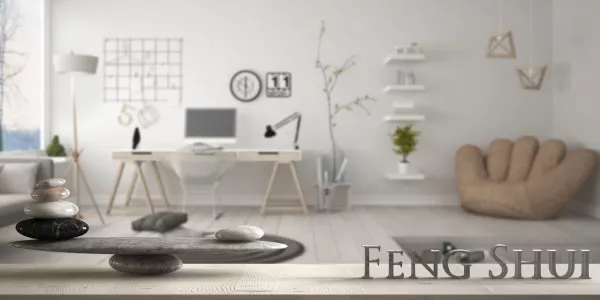Working in an environment where it feels that everything is flowing and growing affects our productivity and well being. We are not talking about a simpler organization, but feng shui.
Feng Shui, a time-honored Chinese tradition and belief system, emphasizes the circulation of energy. By integrating it into office environments, it can significantly contribute to establishing a more serene and efficient work area.
You are reading the right post if you are looking to delve into the essence of Feng Shui for office spaces, looking for guidance on how to transform your workspace into a sanctuary of creativity, efficiency, and growth.
What Is Feng Shui?
Feng Shui, literally translating to "wind-water", is an ancient Chinese practice that aims to harmonize individuals with their environment through spatial arrangements and orientation. It's grounded in the belief that our surroundings can significantly influence our energy, mood, and overall well-being.
By aligning objects and spaces in a manner that optimizes the flow of 'chi' or life energy, Feng Shui seeks to enhance prosperity, health, and harmony in our lives.
The design and arrangement of your office can profoundly affect your clarity, productivity, and stress levels. Feng Shui offers a unique lens to examine and reconfigure your workspace, ensuring it supports your ambitions and nurtures your well-being. A good feng shui can help in minimizing distractions, enhancing creativity, and fostering positive relationships among colleagues.
What is the relationship between the 5 elements and feng shui?
The relationship between the five elements and Feng Shui is foundational and deeply ingrained in its practice. These elements—wood, fire, earth, metal, and water—are considered the building blocks of everything in the universe, including the energy within our environments. In Feng Shui, balancing these elements in a space is crucial for promoting harmony, balance, and positive chi (energy flow).
Each element represents different qualities and is associated with specific colors, shapes, and materials, which can be incorporated into an environment to enhance certain aspects of life:
Wood
Symbolizes growth, vitality, and flexibility. In an office, wood elements can be introduced through plants, wooden furniture, or green colors, promoting creativity and growth.
Fire
Represents energy, transformation, and passion. The use of reds, oranges, or lighting can introduce fire elements, fostering enthusiasm and leadership qualities.
Earth
Stands for stability, nourishment, and protection. Earthy tones, ceramics, and square shapes can enhance a sense of security and balance in a space.
Metal
Embodies clarity, precision, and efficiency. Metal elements can be incorporated through white, gray, metallic objects, or circular shapes, promoting organization and focus.
Water
Symbolizes wisdom, fluidity, and abundance. Mirrors, glass, or blue and black colors can introduce water elements, supporting calmness, clarity, and career advancement.
What is the Bagua map?

The Bagua map is a fundamental tool in Feng Shui that serves as an energy blueprint for analyzing and optimizing the flow of chi, or life force, within a space. It is essentially an energy grid that overlays the floor plan of a home, office, or room, dividing the space into nine key areas or sectors that correspond to different aspects of life.
Each area is associated with specific life aspects, elements, colors, and shapes, providing guidance on how to enhance energy flow and harmony in those aspects.
The nine areas represented in the Bagua map are:
Wealth and Prosperity (top left corner)
Associated with abundance and financial success, often enhanced by the color purple, wood elements, and healthy plants.
Fame and Reputation (top center)
Relates to how one is perceived by others and personal growth, with the fire element and red hues to enhance this area.
Love and Marriage (top right corner)
Focuses on relationships and emotional connections, often enhanced by pink, red, and earth elements.
Family and Health (middle left)
Pertains to family ties and physical health, with green, blue, and wood elements to support this sector.
Health (center)
The heart of the home, symbolizing health and well-being, often balanced with earthy tones and elements.
Children and Creativity (middle right)
Linked to creativity, future, and offspring, enhanced with metal elements and white or pastel colors.
Knowledge and Wisdom (bottom left corner)
Related to personal growth and self-cultivation, with blue, green, and earthy elements to support learning.
Career and Life Path (bottom center)
Focuses on career and life journey, often associated with the water element, black or dark tones.
Helpful People and Travel (bottom right corner)
Pertains to support from others and new experiences, enhanced with gray, white, and metallic elements.
What is Good Feng Shui for Office?
An optimal Feng Shui office layout nurtures seamless energy flow, with the desk arranged to overlook the entrance without facing it directly, ensuring the space is bathed in natural light and remains uncluttered.
The strategic inclusion of greenery and water elements elevates the beneficial chi, while the meticulous placement of furniture, selection of color palettes, and decorative accents achieve a synergy among the five elements—wood, fire, earth, metal, and water.
This harmony not only enhances productivity and well-being but also establishes a balanced, serene setting that encourages positive energy circulation and diminishes potential hindrances.
Everything starts with the "command position."
Choosing the Command Position for Your Desk
This crucial spot, tied to the Career & Life Path area, determines where your desk should be. The perfect spot for your desk offers an unobstructed view of the room, allowing you to easily see anyone who comes in. A sturdy wall should support your back, offering a full view of the entrance. A correctly positioned command spot fosters a sense of authority, security, balance, and vision.
Arranging Chairs and Computers
The way your office chair is positioned matters too. Ideally, it should face the entrance, but if that's impractical, ensure you're not turning your back to the door. Choose a supportive chair and position it against a solid wall for added stability. For your computer, avoid window-side placement to prevent screen glare.
Importance of Natural Light
Natural light is essential for boosting mood and energy, playing a significant role in Feng Shui. Studies have shown that office lighting can significantly affect employee well-being, alertness, comfort, and safety. To enhance natural lighting, consider large windows or strategically positioned mirrors.
Incorporating Plants, Feng Shui Items, and Colors
Incorporate plants to clean the air and bring in vibrant energy. Select a few meaningful Feng Shui objects that reflect your goals, ensuring there's ample space for Chi to circulate. A small water fountain can add a tranquil element to your space.
Where is the Best Place to Sit in an Office Feng Shui?
In Feng Shui, the best place to sit in an office is a position of power, often referred to as the "command position". This position allows you to see the door without being directly in line with it, usually diagonally across the room. It symbolizes stability, control, and visibility, enabling you to welcome opportunities and tackle challenges more effectively.
Which Direction Should I Sit in an Office for Growth?
The direction you face while sitting in your office can influence your growth and success. While this can be personalized based on your Kua number (an individual's Feng Shui energy number), a general guideline is to face one of your favorable directions according to the Feng Shui Bagua map.
For many, facing south can enhance fame and recognition, while facing east may promote health and family harmony.
Incorporate Feng Shui Into Your Desk
Your desk is a focal point in your office Feng Shui. Keep it clutter-free and organized to encourage a clear mind. Position your computer in the North or East sector of your desk to foster career growth or in the Southeast to enhance wealth. Incorporating plants like bamboo can promote vitality, and placing a crystal on your desk can aid in clarity and energy flow.
Feng Shui Office Ideas

To bring Feng Shui to your life and incorporate it in your office, it's essential to understand how each element contributes to creating a balanced and harmonious workspace conducive to productivity and well-being.
1. Soft, Neutral Colors
Soft, neutral colors such as beige, light gray, or soft pastels can significantly impact the ambiance of an office. These colors are believed to ground the energy in a space, promoting a sense of calm and tranquility.
They serve as a subtle backdrop that doesn't overwhelm the senses, allowing for better concentration and stress reduction. In Feng Shui, these colors are often associated with the Earth element, which brings stability and nourishment.
2. Natural Light and Ventilation
The presence of natural light and fresh air is pivotal in Feng Shui as it invigorates the space with positive energy or 'chi.' Natural light not only enhances mood and energy levels but also improves health and well-being by reducing eye-strain and fatigue.
Good ventilation ensures a constant flow of fresh air, which helps to clear negative energies and promote a refreshing and vibrant work environment. Consider positioning the workspace to maximize exposure to natural light and ensure windows can be opened for fresh air.
3. Desk in Command Position
The command position is about placing the desk so you can see the door without being directly in line with it. This strategic placement symbolizes control, readiness, and the ability to tackle incoming opportunities or challenges.
It provides a psychological sense of security, as you're not vulnerable to unseen surprises from behind. A solid wall behind the desk offers support, metaphorically and literally, reinforcing your strength and stability in your professional role.
4. Plants and Water Elements
Integrating plants into an office space introduces the Wood element, which is associated with growth, vitality, and flexibility in Feng Shui. Plants can improve air quality, add a touch of nature, and subtly enhance the flow of positive energy.
Small water elements like fountains introduce the Water element, known for its properties of abundance, fluidity, and tranquility. The gentle sound of flowing water can also have a soothing effect, reducing stress and promoting relaxation.
5. Strategic Use of Mirrors
Mirrors in Feng Shui are used to amplify and redirect energy. When placed strategically, they can create the illusion of more space, making a small office feel larger and more open. Mirrors can also be used to reflect light into darker corners, brightening the space and enhancing the energy flow. However, it's important to position mirrors where they reflect pleasant views and not clutter or sources of stress.
People also ask
Can Feng Shui impact team dynamics?
Absolutely. A well-arranged office can enhance communication and cooperation among team members, fostering a more collaborative and positive working environment.
Is it costly to implement Feng Shui in my office?
Not necessarily. While you can invest in consultations and specific Feng Shui items, many principles like decluttering, rearranging furniture, and adding simple elements like plants or mirrors can be done cost-effectively.
How quickly can I see results from Feng Shui adjustments?
The effects can be immediate in terms of how you feel in your space. However, tangible outcomes, such as improved productivity or career growth, can vary and may take time to manifest.

 Marcio Vasconcelos
Marcio Vasconcelos





